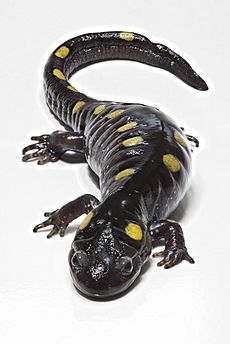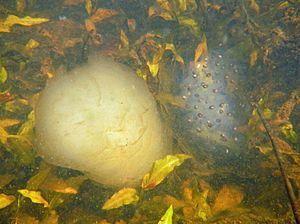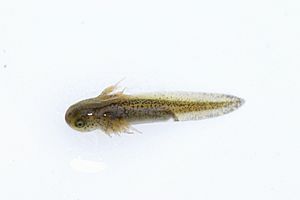Spotted salamander facts for kids
Quick facts for kids Spotted salamander |
|
|---|---|
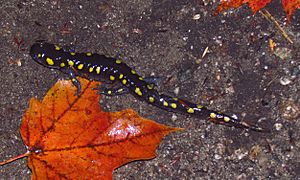 |
|
| Conservation status | |
| Scientific classification | |
| Genus: |
Ambystoma
|
| Species: |
maculatum
|
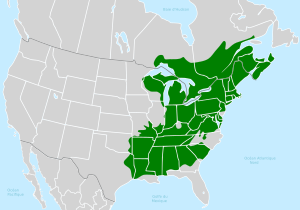 |
|
| Range of A. maculatum | |
| Synonyms | |
|
|
The spotted salamander (Ambystoma maculatum) is a type of mole salamander. You can find these cool amphibians in the eastern parts of the United States and Canada. It's even the official state amphibian for Ohio and South Carolina! These salamanders live in a wide area, from Nova Scotia all the way down to southern Georgia and Texas.
What's really neat about them is that their babies (embryos) have tiny symbiotic algae living inside and around them. This is a special partnership where both the algae and the salamander benefit. It's one of the only known examples of an animal's cells hosting another living thing inside them!
Contents
Description
The spotted salamander is usually about 15 to 25 centimeters (6 to 10 inches) long. They have a strong, sturdy body, like most mole salamanders, and a wide snout. Their main color is black, but some can be a bit bluish-black, dark gray, dark green, or even dark brown.
They get their name from the two rows of yellowish-orange spots that run along their back. These spots start near their eyes and go all the way to the tip of their tail. The spots near their head are often more orange, while the ones on the rest of their body are more yellow. The underside of the salamander is a dull gray and pink.
Did you know that male and female spotted salamanders can look a little different? Females tend to be larger. Also, their spots are often brighter than the males' spots.
The scientific name Ambystoma maculatum tells us something about them. Ambystoma comes from Greek words meaning "blunt mouth." Maculatum comes from a Latin word meaning "spotted." So, it's a "blunt-mouthed spotted" animal!
Habitat
Spotted salamanders usually live in older forests. They need ponds or special temporary pools called vernal pools for breeding. Vernal pools are perfect for them because they often dry up. This means fish, which would eat salamander eggs and larvae, can't live there. But the pools stay wet long enough for the young salamanders to grow and change into adults that live on land.
Salamanders from different pools can be related, but they don't mix too much if the pools are far apart. Salamanders from pools within about 4.8 kilometers (3 miles) tend to share more genes. This means they are more likely to be related.
Behavior
Spotted salamanders are fossorial, which means they spend most of their time underground. They don't come out very often, usually only after it rains, or when they are looking for food or a mate.
During winter, they go into a deep sleep called brumation underground. They won't be seen again until spring, usually from March to May, when it's time to breed.
These salamanders have several ways to protect themselves. They can hide in burrows or under leaves. If a predator grabs their tail, they can even drop it off! This is called autotomy. They can also release a milky, toxic liquid from glands on their back and neck when they feel threatened.
Like other salamanders, spotted salamanders are amazing at growing back body parts. If a predator bites off a leg, tail, or even parts of their head or organs, they can regrow it! But this takes a lot of energy. Young salamanders often hide under leaves at the bottom of the pools where they hatched. They stay still if predators are nearby.
Spotted salamanders often follow the same paths when they travel between their underground homes and their breeding ponds. They can do this even when they can't see well, like on cloudy nights. Some studies show they can learn landmarks, like certain trees or rocks, to help them find their way. They might also use these landmarks to find food.
Diet
Spotted salamanders eat many different things. Their diet includes:
- Earthworms
- Slugs
- Snails
- Spiders
- Millipedes
- Centipedes
- Insects
- Algae
- Other small invertebrates
Sometimes, they even eat smaller salamanders, like the red-backed salamander. Adult spotted salamanders use their sticky tongue to catch their food.
Life cycle
For most of the year, spotted salamanders live hidden under leaves or in burrows in forests. But when the weather gets warmer and it's very wet, they suddenly move towards their breeding ponds. Sometimes, hundreds or even thousands of salamanders will travel to their ponds in just one night to find a mate! Males often start migrating earlier than females.
They usually breed in ponds during spring rains. Females lay about 100 eggs at a time. These eggs stick to underwater plants and form jelly-like clumps called egg masses.
These egg masses are round and feel like jelly. They are usually about 6 to 10 centimeters (2.5 to 4 inches) long. Spotted salamander egg masses can look different: some are clear, and some are white. The clear ones have a protein that dissolves in water, while the white ones have a different kind of protein. Scientists think these different types of egg masses help the salamanders survive better in different kinds of pools. They might also help protect the eggs from being eaten by wood frog larvae.
Adults only stay in the water for a few days after laying eggs. The eggs then hatch in one to two months, depending on how warm the water is.
A cool thing about A. maculatum eggs is their special partnership with a type of green alga called Oophila amblystomatis. The jelly around the eggs keeps them from drying out, but it also makes it hard for oxygen to get in. Oxygen is needed for the babies to grow. The Oophila alga helps by making more oxygen through photosynthesis. It also gives the growing salamander extra food from the carbon it makes. In return, the alga uses the carbon dioxide that the salamander embryo breathes out. This partnership helps the salamander babies grow better.
When they hatch, the larvae (baby salamanders) are usually light brown or greenish-yellow. They have small dark spots and are born with external gills, which look like feathery growths on their heads. These gills help them breathe underwater. In two to four months, the larvae lose their gills and change into juvenile salamanders that can live on land.
Spotted salamanders have been known to live for a long time, up to 32 years! They usually return to the same vernal pool to breed every year. These pools are seasonal, meaning they often dry up in late spring and stay dry until winter.
Predators
Spotted salamanders can be eaten by animals like raccoons, skunks, turtles, and snakes. Sadly, humans are also a big threat because these salamanders are sometimes caught for the pet trade.
See also
 In Spanish: Salamandra moteada para niños
In Spanish: Salamandra moteada para niños



